Instructions for Side by Side Printing
- Print the notecards
- Fold each page in half along the solid vertical line
- Cut out the notecards by cutting along each horizontal dotted line
- Optional: Glue, tape or staple the ends of each notecard together
Practice Exam 3
front 1  In the shoulder diagram to the right, the letter "X" is
located next to which scapular border? | back 1 D. Medial border -The scapula has three borders, superior, lateral (axillary), and medial (vertebral) |
front 2 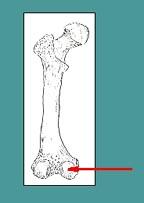 The red arrow is pointing to which part of the femur? | back 2 D. Medial condyle -Remember, the head of the femur is medial and fits into the
acetabulum. Therefore, the red arrow is pointing toward |
front 3 Which of the following could be considered a reservoir for
infection? | back 3 D. 1, 2 & 3 |
front 4 While imaging a patient with chest tube drainage, which of the
following actions must be taken? | back 4 B. Keep drainage tube below chest -When a patient has chest tube drainage it is imperative that
the tubing be kept below the level of the chest. This way the
material being |
front 5 The brightness of a digital image affects which of the
following? | back 5 B. Visibility of detail -The image must be a certain brightness to make the details visible. A digital image can be too light or too dark. |
front 6 What separates the head of the humerus from the body (shaft) of the
humerus? | back 6 A. Anatomical neck -Directly below the head of the humerus is a narrowed area called the anatomical neck |
front 7 Where would the CR enter for a cross-table (horizontal beam) lateral
on a patient with a suspected hip fracture? | back 7 D. Femoral neck |
front 8 Oxygenated blood returns from the lungs, through the pulmonary veins,
to which chamber of the heart? | back 8 B. Left atrium -The blood then passes through the mitral valve, into the left ventricle and then out the aortic valve into the ascending aorta |
front 9 What position is the patient's right arm in when radiographing the
upper right posterior ribs in the RPO position? | back 9 C. Abducted and elevated -This brings the right scapula away from the rib cage |
front 10 Which of the following exposure indicator optimal value ranges is/are
correct? | back 10 D. 1, 2 & 3 |
front 11 Which of the following sequences of examinations is correct? | back 11 C. Gallbladder Sonography, Barium Enema, Upper GI -The gallbladder sonography and nuclear medicine scans need to be done before any barium is placed in the body. Then the B.E., because that barium won't interfere with the UGI the following day. |
front 12 How many half value layers (HVL) are required to reduce an x-ray beam
from 10 mR/mAs to 5 mR/mAs? | back 12 A. 1 -A half value layer is the amount of material that will reduce the intensity of an x-ray beam in half. Therefore, 1 HVL will reduce 10 mR to 5mR. |
front 13 Long bone measurements are taken radiographically for which of the
following reasons? | back 13 B. Length differences between two sides -A special metal ruler is used to measure the length of long bones on patients who have different bone lengths |
front 14 Which of the following will cause a loss in spatial
resolution? | back 14 C. Motion -Motion can cause a loss of spatial resolution because the area of interest will be blurred. |
front 15 According to the Code of Federal Regulations Title 21 (21 CFR) for
fluoroscopic equipment manufactured after June 10, 2006, the AKR nor
the cumulative air kerma shall not deviate from the actual values by
more than _______ percent. | back 15 C. 35 -Compliance shall be determined over the range of 6 mGy/min and 100 mGy to the maximum indication of AKR and cumulative air kerma. |
front 16 During a barium enema, if the patient is supine, the CR angled 30-40
degrees cephalad, 2" inferior to the level of the ASIS and to the
midsagittal plane, what anatomy is best demonstrated? | back 16 C. Rectosigmoid -This is known as an AP axial projection. The rectosigmoid
segment of the large intestine may also be demonstrated with a PA
axial |
front 17 Which of the following types of primary radiation CANNOT be produced
at tube potentials of less than 70 keV? | back 17 D. Characteristic -Primary radiation is produced with either bremsstrahlung or characteristic interactions. It takes at least 70 keV to remove the K-shell electron to produce characteristic radiation. |
front 18 A patient with known salmonella pathogens has an "accident"
on your x-ray table. What should you do with the contaminated sheets
and pillow case? | back 18 A. Place them with the other dirty linen as usual -All linen is considered contaminated, so this case is no
different than all cases. The linen is placed in a water proof hamper
and handled |
front 19 What post-examination instructions should be given to a patient
following a myelogram? | back 19 D. Elevate head 30 degrees for six hours |
front 20 As an x-ray beam passes through a material its intensity is reduced.
What is this called? | back 20 D. Attenuation |
front 21 According to the Code of Federal Regulations Title 21 (21 CFR),
fluoroscopic equipment manufactured after June 10, 2006 must meet
which of the following standards? | back 21 D. All of the above |
front 22 Which of the following describes the x-ray beam after it has passed
through the patient? | back 22 A. Remnant (exit) -Remnant means remaining. Remnant (exit) radiation is what is remaining in the beam after it has passed through the patient |
front 23 A scoliosis series involves PA projections of which of the following
areas? | back 23 B. Thoracic and lumbar spines -The thoracic and lumbar vertebrae must be shown along with 1 - 2 inches of the iliac crest |
front 24 Accurate centering of the central ray is critical for which type of
grid? | back 24 C. Focused -Off-center grid cut-off is more likely with a focused grid |
front 25 Which of the following is the major source of exposure to the
radiographer? | back 25 B. Scatter x rays Scatter radiation from the patient produces the greatest risk to the radiographer, but "backscatter" from the floor and walls, and leakage radiation cannot be ignored. The radiographer should never be in the path of the primary beam. |
front 26 Which of the following technical factors will cause receptor exposure
to decrease when it is increased? | back 26 C. SID -According to the inverse square law, intensity of the x-ray beam decreases when distance increases. |
front 27  The quality assurance test at the right helps determine which of the
following? | back 27 D. Beam alignment |
front 28 Which of the following is a postprocessing option to increase the
contrast along the borders of a digital image? | back 28 B. Edge enhancement -Edge enhancement improves the visibility of details. |
front 29 When using anatomically programmed technique (APT) with a digital
system and an average size patient, the radiographer changes the
density control to -2. Which of the following would result? | back 29 D. 2 & 3 only |
front 30 When the x-ray beam is traveling in an anterior to posterior
direction through a patient, with the image receptor touching his
back, which of the | back 30 D. 1 & 3 only |
front 31 Medical asepsis is defined as the _______ of pathogens in the
environment? | back 31 C. reduction in the number -Medical asepsis is reducing the number of pathogens by washing and cleaning objects that come in contact with patients. |
front 32 For an AP projection of the sacroilliac joints, the central ray
enters on the midsagital plane at what angle? | back 32 D. 30 to 35 degrees cephalad |
front 33 What is the name of the largest blood vessel in the abdomen? | back 33 C. Aorta -The aorta leaves the heart and is referred to as the thoracic aorta above the diaphragm and the abdominal aorta below the diaphragm. |
front 34 Which of the following primary beam sizes would produce the greatest
radiation exposure to the patient? | back 34 D. 14 x 17 |
front 35 Which of the following oxygen delivery systems would indicate the
patient needs a high rate of oxygen supply? | back 35 C. Nonrebreathing mask -This high flow system has a reservoir bag attached and prevents rebreathing exhaled air |
front 36 Which of the following would describe a hemiplegic? | back 36 C. Paralyzed on one side -Hemiplegia indicates paralysis (-plegia) of half (hemi-) of the body, in this case, one side. |
front 37 If the mAs is 40 and the time is .1 second, the mA setting must be
what? | back 37 D. 400 mA |
front 38 During fluoroscopy, where is an acceptable position for the
radiographer to stand? | back 38 C. In the room, as far from the patient as practical -The patient is the primary source of radiation exposure to the radiographer. Take a step back away from the fluoroscopy unit whenever possible. |
front 39 The American Heart Association's guidelines for CPR recommends which
of the following sequences? | back 39 B. Compressions, airway, breathing -By changing the sequence from ABC to CAB, compressions will be initiated sooner and starting with compressions may encourage more bystanders to begin CPR. |
front 40 In digital imaging, even though mAs is the controlling factor for
receptor exposure, what advantage does the kVp 15% rule have in the
adjustment | back 40 D. 1, 2 & 3 |
front 41 Cystography is a radiographic examination of which anatomical
part? | back 41 A. Bladder -Cystography is done by injecting contrast media through a urethral catheter into the urinary bladder |
front 42 Which of the following is necessary for a true lateral position of
the forearm? | back 42 D. 1, 2 & 3 |
front 43 If an unattended patient is injured by falling off the x-ray table,
why could the radiographer be sued? | back 43 D. Negligence |
front 44 How long should a patient remain in the upright or lateral decubitus
position before an exposure is made to demonstrate free air in
the | back 44 C. 5 minutes -5 minutes is the recommended time to leave a patient in the upright or lateral decubitus position so the free air and fluid have time to move |
front 45 Which manufacturer refers to its exposure indicator as a log median
number? | back 45 A. Agfa -Agfa uses a logarithmic number to indicate its imaging plate exposure. |
front 46 Which of the following anatomical areas should be covered with
protective shielding when they are in or near a properly collimated
beam? | back 46 D. 1, 2 & 3 |
front 47 An AP axial sacrum requires the patient to be supine, the CR angled
15-25 degrees cephalad, and entering a point: | back 47 B. 2" superior to the symphysis pubis. -The CR is angled 15-25 degrees cephalad to enter at a point 2" superior to the symphysis pubis |
front 48 Which of the following combinations will reduce patient exposure the
most? | back 48 C. Increase kVp and decrease mAs -By increasing kVp and decreasing mAs, the amount of radiation can be reduced while maintaining radiographic brightness |
front 49 First-stage entrance-shutters of a variable-aperture collimator are
designed to reduce which of the following? | back 49 D. Off-focus radiation |
front 50 Bone marrow is the largest producer of blood cells in the human body.
Which of the following bone types contain the most bone
marrow? | back 50 A. Flat bones -The pelvis, skull, ribs, and sacrum are flat bones that contain blood producing marrow and should be avoided or shielded when imaging a patient if possible. |
front 51 Which of the following is/are necessary for a patient with contact
precautions? | back 51 D. 1, 2 & 3 |
front 52 Which of the following is a recumbent position in which the patient's
head is higher than his/her feet? | back 52 D. Fowler's |
front 53 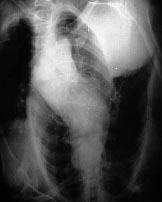 What caused the artifact that is demonstrated on this
radiograph? | back 53 B. Double exposure -This is a common mistake while doing several mobile chest radiographs. The radiographer forgot which cassette had already been exposed and created this double exposure. |
front 54 How are the electrons focused toward the anode of a typical x-ray
tube during an exposure? | back 54 D. Focusing cup |
front 55 Which of the following terms describes the intensity of the x-ray
beam? | back 55 B. Quantity -Intensity is the number of x rays per area. Quantity refers to the number of x rays |
front 56 What is a major benefit of a fixed kVp technique chart? | back 56 C. Consistent radiographic contrast -A fixed kVp chart has the kVp set higher than necessary, which produces a more consistent long scale of contrast. |
front 57 Which of the following can be used to clean the outside of a CR
cassette? | back 57 D. All of the above |
front 58 How does the SNR (signal to noise ratio) affect the quality of a
digital image? | back 58 D. The higher the SNR the better the quality of the image |
front 59 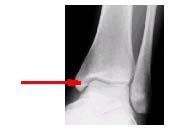 In the radiograph to the right, the red arrow is pointing to which of
the following anatomical parts? | back 59 A. Medial malleolus -The medial malleolus is at the distal end of the tibia and helps form the ankle joint |
front 60 From a radiograph, how does one tell if a PA axial (Caldwell)
projection of the skull was correctly positioned? | back 60 D. The petrous ridges are projected into the lower 1/3 of the
orbits |
front 61 Which of the following is NOT necessary for the production of x
rays? | back 61 C. Magnetic field -Whenever high speed electrons are suddenly stopped or
change direction, some or all of their kinetic energy is given up in
the form of |
front 62 f a dynamic recording of a fluoroscopic image is required, how many
frames per second must be recorded? | back 62 C. 30 -In order to perceive a dynamic image, at least 30 frames per second must be recorded. The new flat panel detectors used for digital fluoroscopy can record 30 fps. |
front 63 A lead apron is designed to protect the radiographer from scatter
radiation. A protective apron must have a lead equivalency of at
least: | back 63 B. .50 mm. -The NCRP changed their recommendation from .25 mm Pb to .50 mm Pb equivalent for lead aprons. Lead gloves changed from .50 mm Pb to .25 mm Pb. |
front 64 Which of the following must be taken into consideration when
determining the thickness of a protective barrier? | back 64 D. All of the above |
front 65 While doing an erect abdomen image, the patient warns you that he/she
is about to faint. What should be your first reaction? | back 65 D. Carefully lower the patient to the floor and have him/her lie
down |
front 66 Which of the following would NOT be considered ambient light in a
radiologist's reading room? | back 66 A. Light from the display monitor -Light from the display monitor is referred to as luminance |
front 67 Which of the following are considered ways of assessing a patient's
condition? | back 67 D. 1, 2 & 3 |
front 68 Which of the following must be done when checking a patient for
radiopaque objects? | back 68 D. 1, 2 & 3 |
front 69 Which of the following prefixes means "below"? | back 69 C. Infra -"infra" is the prefix that means "below", as used in the term "inframammary" (below the breast). |
front 70 Edema describes which of the following conditions? | back 70 B. Swelling -Edema is an accumulation of fluid in tissues and is commonly seen in patients with a sprained ankle |
front 71 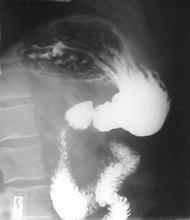 What position/projection is demonstrated on this radiograph? | back 71 B. Right lateral -The lateral vertebrae help to identify this as a right lateral stomach |
front 72 When a patient is being registered, that person's information is
being typed into which of the following? | back 72 A. HIS -When a patient is registered, that information is put into the hospital information system (HIS). The radiology information system (RIS) and other hospital intranets then have access to that information. |
front 73 Which of the following must be done to correct a saturated digital
image? | back 73 D. The image must be repeated. |
front 74 Which of the following is an appropriate way to make sure you have
the correct patient and are doing the correct procedure? | back 74 C. Check wrist band and ask the patient for his/her date of birth -Checking the wrist band and asking for date of birth are the two accepted means of assuring you have the correct patient. |
front 75 Which of the following people have the authority to restrain a
patient? | back 75 D. Patient's physician |
front 76 If ureteral reflux is suspected during cystography, which of the
following radiographs is necessary? | back 76 C. Voiding -Ureteral reflux is the backward flow of urine up the ureter during urination. |
front 77 What is the proper way to move a heavy object? | back 77 A. Push it -Trying to lift or pull a heavy object puts undue stress on your shoulders and lower back. Pushing allows you to get your weight behind the object. |
front 78 Which of the following structures should be filled with air for a
soft tissue neck radiograph? | back 78 D. 1, 2 & 3 |
front 79 When should a grid be used? | back 79 D. 1, 2 & 3 |
front 80 How would a crack in an imaging plate appear in a digital
image? | back 80 A. White -If there is a crack in the imaging plate, no light would be produced in that area. Therefore, the pixel value would be 0, so it would appear white. |
front 81 What criteria should be used to make sure a lateral position of the
wrist is of optimum quality? | back 81 A. The ulnar head and radius should be superimposed -In order to get a true lateral of the wrist, the patient's arm and forearm must be resting on the table, the elbow flexed 90 degrees and the ulnar head and radius superimposed. |
front 82 You and a co-worker are on the weekend shift. It is a busy department
for a small hospital and it demands a great deal of effort from both
of you. Your co-worker frequently leaves the department to deal with
his personal problems. You do not know much about the circumstances,
nor have you known him for long. Some days your co-worker helps very
little, and, as a result, you are putting in an excessive amount of
overtime to get the patients done. You feel that your health may begin
to suffer because of the stress and the overtime. Which of the
following is the appropriate response? | back 82 A. Raise the issue with your department manager. Explain that the patients are not being done in a reasonable time because -It is your manager's job to solve this problem. Overworking yourself or lying to your manager is not the solution. |
front 83 Which of the following will cause magnification? | back 83 D. Increased OID |
front 84 The capitullum of the humerus articulates with which of the following
anatomical structures? | back 84 B. Head of the radius -A good way to remember this is that a cap fits on your head. The capitullum articulates with the head of the radius! |
front 85 What is an imaging contrast agent called that absorbs more x rays
than the surrounding tissue? | back 85 C. Positive contrast agent -A positive contrast agent has a high atomic number, either barium sulphate or iodine |
front 86 Which of the following will reduce patient exposure during
fluoroscopy? | back 86 A. 1 & 2 only -Newer digital, fluoroscopic units use a pulsed beam instead of a continuous beam to produce the images, reducing patient exposure. A radiologist can use an intermittent beam instead of a continuous beam to reduce patient exposure. |
front 87 What is the name of the spongy pad that lies between the
vertebrae? | back 87 B. Intervertebral disk -Intervertebral disks are found between the bodies of the vertebrae. They act as shock absorbers |
front 88 Inspiration and expiration PA projections of the chest may be used to
demonstrate which of the following? | back 88 B. Pneumothorax -Other indications for inspiration and expiration views of the chest are foreign body localization, diaphragm movement or to distinguish between an opacity in the rib or lung. |
front 89 Which of the following positions would be best when radiographing the
sternum of a trauma patient? | back 89 A. LPO -Even though the sternum is further from the image receptor in this position, it is easier on the patient and reduces the risk of further injury |
front 90 When should the timing for a small bowel series begin? | back 90 B. When the patient swallows the barium -Since fluoroscopy time varies with patients and radiologists, to maintain consistency, the timing of a small bowel series should begin when the patient first swallows the barium |
front 91 If you were alone with a patient that you felt was going into
cardiogenic shock, which of the following should you do while you are
waiting for help | back 91 A. Put a blanket on the patient and elevate his feet -Shock is a result of poor blood supply to the vital organs. If you feel your patient may be going into shock because he is restless, has a rapid heart rate, lacks color, and has cold, clammy skin. Your first response is to call for help. Then you should cover him, elevate his feet and reassure him that help is coming soon. |
front 92 Which of the following postprocessing techniques could be used while
evaluating a digital image for central line placement within
the | back 92 D. Invert the image |
front 93 When a residual latent image appears on a subsequent CR digital image
it is known as what? | back 93 C. Ghost image -A ghost image can be caused by overexposing the original image or by inadequate erasing of the original imaging plate |
front 94 A sampling frequency of 5 pixels per millimeter would produce how
much spatial resolution? | back 94 A. 2.5 line pairs per millimeter -It takes 2 pixels to make a line pair, therefore, 5 pixels would produce 2.5 line pairs per millimeter. |
front 95 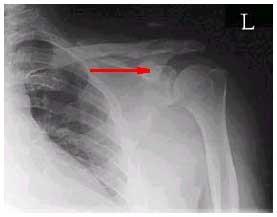 In the image to the right, the red arrow is pointing to which of the
following anatomical parts? | back 95 D. Coracoid process |
front 96 Which of the following positions/projections will produce the least
exposure to the thyroid gland during a cervical spine radiographic
series? | back 96 B. PA -A PA projection of the cervical spine will cause the lower energy x-rays to be absorbed before they ever reach the thyroid gland. |
front 97 Which of the following can be detrimental to viewing digital images
on a monitor? | back 97 C. Ambient light -Ambient light refers to the overall illumination of a room. It consists of natural light, fluorescent lights and lamps. Ambient light is reflected off the monitor and can reduce the contrast of an image. |
front 98 What is the function of the National Council on Radiation Protection
and Measurement (NCRP)? | back 98 A. Set standards for using radiation -The National Council on Radiation Protection and
Measurements (NCRP) sets standards for the measurement of and the
protection from |
front 99 Which of the following will result in an underexposed radiograph
while using automatic exposure control (AEC)? | back 99 A. Insufficient backup time set -When the backup time is reached, it will terminate the exposure even though the AEC would require more x rays to terminate the exposure |
front 100 Which of the following will put the humerus in a true AP
projection? | back 100 D. AP external rotation |
front 101 Which of the following can be done to reduce the patient's skin dose
during prolonged fluoroscopic examinations? | back 101 D. All of the above |
front 102 Which of the following positions/projections will best demonstrate
the coronoid process of the elbow? | back 102 B. Medial oblique -The medial oblique shows the coronoid process free from superimposition. The lateral oblique shows the radial head. |
front 103 Managing patient information, patient orders, and scheduling
information in the Imaging Department is done on computers using RIS.
What does RIS stand for? | back 103 A. Radiology information system -The software that is used for these purposes in the Imaging Department is referred to as the radiology information system. |
front 104 Children have a greater sensitivity to radiation than adults. Which
of the following should be done to keep radiation exposure to children
to a minimum? | back 104 D. All of the above |
front 105 Which of the following positions/projections would best demonstrate a
right pleural effusion? | back 105 B. Right lateral decubitus -Pleural effusion is an accumulation of fluid in the
pleural cavity (a double-walled membrane that surrounds the lungs).
It is best demonstrated |
front 106 Tube angulation will produce which type of shape distortion? | back 106 C. Elongation -Elongation makes the object to appear longer that it actually is. It occurs when the tube is angled or when the tube and image receptor are not properly aligned. |
front 107 Which of the following interactions with matter leaves an atom
ionized? | back 107 B. Compton effect and photoelectric absorption -Both of these interactions results in an incoming photon striking an electron and ejecting it from its energy shell, thereby, leaving the atom with more positive charges than negative charges (ionized). |
front 108 Which of the following positions/projections clearly demonstrate all
four paranasal sinuses? | back 108 D. Lateral (horizontal beam) |
front 109 What is the definition of amorphous? | back 109 A. A noncrystalline state of an otherwise crystalline material -Amorphous is defined as a noncrystalline state of an otherwise crystalline material. |
front 110 What instructions could a radiographer give to a patient following a
small bowel series? | back 110 A. Drink plenty of liquids -Since barium can become hardened in the large bowel, the radiographer can tell the patient to drink plenty of liquids. It is not appropriate for a radiographer to instruct the patient to take a laxative. It may be contraindicated for some patients. |
front 111 What do the letters RBE stand for? | back 111 C. Relative biological effect -RBE describes the capability of various radiations to produce a particular biological effect. |
front 112 What part of the CR imaging plate is used to match the imaging plate
to a particular patient/examination? | back 112 B. Barcode -A barcode is printed on the back of the plate which is read by a barcode reader to match the imaging plate to a patient/examination. |
front 113 Which of the following would best demonstrate a blow-out fracture of
the orbit? | back 113 C. Modified parietoacanthial (modified Waters) -The difference between a Waters and modified Waters is that the modified Waters has the chin and nose resting on the tabletop, which makes the OML form a 55 degree angle with the image receptor. A Waters forms a 37 degree angle when the nose does not touch the tabletop. |
front 114 The body part _______ the image receptor is referenced when
describing the term "position". | back 114 C. nearest -The term position refers to a specific body position, oblique or decubitus, in which the body part nearest the image receptor describes the position. For example, a right anterior oblique would have the right anterior side nearest the image receptor. |
front 115 At a 40" SID, the collimator light-to-x-ray field must be
accurate to within how many inches? | back 115 B. 0.8" -2% of 40" equals 0.8" |
front 116 Going from the easiest to penetrate to the hardest to penetrate,
which of the following is in the correct order? | back 116 B. Gas, fat, muscle, bone -The less the tissue density, the easier to penetrate |
front 117 What is the name of the organ that lies within the duodenal
loop? | back 117 B. Pancreas -The pancreas lies within the duodenal loop and the main pancreatic duct empties into the duodenum through the sphincter of Oddi. |
front 118 Which of the following terms describes the horizontal portion of the
mandible? | back 118 C. Body -The mandible has a curved, horizontal portion called the body. |
front 119 Which of the following tarsal bones articulates with the talus
anteriorly? | back 119 D. Navicular |
front 120 Which of the following image matrix sizes is necessary to produce
adequate spatial resolution for digital chest radiography? | back 120 D. 2048 x 2048 |
front 121 Which of the following automatic exposure control (AEC) functions
will prevent overexposing the patient in the event of a malfunction
or | back 121 C. Back-up timer -The back-up timer or back-up mAs should be set to approximately 150% of the expected value. |
front 122 Where should the central ray enter for an AP axial projection of the
foot? | back 122 B. Base of the 3rd metatarsal -The base of the 3rd metatarsal is the proximal end of the metatarsal, which is in the center of the foot. |
front 123 The histogram is used to automatically rescale the image to the
proper brightness. Which of the following could cause an error with
the | back 123 D. 1, 2 & 3 |
front 124 What is the definition of a fomite? | back 124 D. An item to which microorganisms cling |
front 125 You received the requests for the following procedures all at the
same time. In what sequence would you perform these
procedures? | back 125 B. 2, 1 then 3 -Emergency patients are always first. Then pediatric and geriatric patients who are fasting. Followed by routine imaging procedures. |
front 126 Which of the following hospital personnel is considered
"qualified" to interpret radiation monitoring
reports? | back 126 C. Certified medical physicist -Radiation monitoring reports must be interpreted by a "qualified expert", a certified medical physicist. |
front 127 A test pattern should be used to evaluate which of the following
monitor qualities? | back 127 D. All of the above |
front 128 You are imaging a patient with head trauma in the emergency room and
he suddenly appears drowsy and confused. What is your
immediate | back 128 B. Notify the ER physician or ER nurse -Always be aware of a patient's clinical symptoms and get help immediately if they change for the worse |
front 129 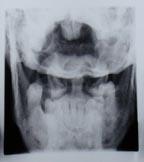 What must be done to correct this radiograph of the dens? | back 129 B. Flex the chin -With the mouth open, flexing the chin will keep the base of the skull from superimposing the dens. The position calls for the upper incisors and the base of the skull to be superimposed. |
front 130 The speed at which the projectile electrons are accelerated across
the x-ray tube is determined by which of the following? | back 130 B. kVp -As kVp increases, the projectile electrons increase in speed. This increase in kinetic energy increases the energy of the resultant x rays. |
front 131 Which of the following describes the part of the fluoroscopic system
designed to maintain a constant image brightness? | back 131 A. Automatic exposure rate control (AERC) -Automatic exposure rate control (ABC) is designed to compensate for changes in patient positioning and/or tube movement during fluoroscopy. |
front 132 Which of the following methods uses light to imprint information onto
an image? | back 132 A. Photographic -This method is used to record patient demographics onto an image |
front 133 Which type of radiation has a greater biological effect on a tissue
when its cells are well oxygenated? | back 133 A. X or gamma radiation -The oxygen effect is important for low LET radiation (x or gamma), but less important for higher LET radiation (alpha particles). Low LET radiation penetrates deeper making a more uniform distribution throughout the cell. |
front 134 Which of the following anatomical structures is at the level of the
iliac crest? | back 134 D. L4-5 interspace |
front 135 Personnel monitoring is required when there is a chance that an
employee will be exposed to: | back 135 B. 1/10 or more of the annual effective dose limits of 50 mSv in any one year -The NCRP #116 requires individuals for whom there is a reasonable probability of exceeding 10% of the occupational effective dose limit (50 mSv/year) in the course of their work to wear a radiation monitor. |
front 136 Digital imaging has created which of the following poor radiation
practices? | back 136 D. All of the above |
front 137 What is the suture between the parietal bones and the occipital bone
called? | back 137 C. Lambdoidal -The sagittal is between the parietals, the coronal is between the parietals and frontal, and the squasmosal is between the parietal and temporal. |
front 138 Which projection of the knee will show the proximal tibiofibular
articulation free from superimposition? | back 138 D. Medial oblique |
front 139 What is the purpose of the photodetector in a CR reader? | back 139 D. It converts photostimulable luminescence into an electric
current |
front 140 Quantum noise in a digital image is the result of which of the
following? | back 140 D. Underexposure |
front 141 When a patient is transported to the imaging department, their chart
is brought with them. Why is their chart brought? | back 141 D. To determine the patient's risk factors |
front 142 When using automatic exposure control (AEC), how can the radiographer
decrease the time of the exposure and still maintain a
satisfactory | back 142 B. Increase the mA -The same principles are true with AEC as they are with manual exposures. An increase in mA or kVp will allow the exposure time to be reduced. |
front 143 What is the name of the plane that divides the body into anterior and
posterior halves? | back 143 D. Midcoronal plane |
front 144 Which of the following documents describes the treatment that is due
a patient? | back 144 C. AHA Patient Care Partnership (Patient's Bill of Rights) -The AHA Patient Care Partnership (Patient's Bill of
Rights) lists a number of rights of a patient. Everything from the
right to know your name |
front 145 What is the shortest portion of the small intestine? | back 145 D. Duodenum |
front 146 Immobilization methods used in radiology: | back 146 A. 1 & 2 only -Immobilization includes temporary methods to help the patient stay still during the x-ray exposure and include tape and sandbags. Unlike restraints, which help protect the patient, these are used only for the procedure |
front 147 The dynamic range of an image display monitor is: | back 147 A. the range of intensities that can be display. -The dynamic range is from the smallest to largest input intensities that can be displayed |
front 148 A flat-panel detector is exposed with nothing between the x-ray tube
and detector. 5 images were acquired on 5 different days using the
same exposure. The pixel readings within a region of interest (ROI)
are compared. What quality control test was performed? | back 148 C. Repeatability -Repeatability checks the stability of the pixel readings over time. |
front 149 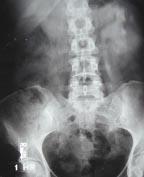 Why was this IVU radiograph repeated? | back 149 B. Motion -Motion is seen in the left kidney area |
front 150 Which of the following is a postprocessing option to remove white
areas from the final digital image that is caused by tight
collimation? | back 150 B. Masking -Digital images that are tightly collimated have clear white areas that can fatigue a radiologist's eyes. Blocking this white light is called masking and it can be done manually or automatically |
front 151 When should a water soluble contrast agent, such as Gastrografin, be
used instead of barium? | back 151 B. 1 & 3 only -Barium sulfate will not be absorbed by the body. Therefore, if there is a "hole" in the gastrointestinal tract, barium would leak into the abdomen and cause infection. Barium would be indicated for children. |
front 152 According to the law of Bergonie and Tribondeau, which of the
following will have the greatest effect on cell
radiosensitivity? | back 152 A. Increased proliferation, immature cell, high metabolic rate -An increased proliferation (reproduction) rate means cells are in the metaphase stage of mitosis more often and therefore, more radiosensitive. An immature cell cannot repair itself from radiation damage as well as a mature cell. A high metabolic rate increases the radiosensitivity of cells. |
front 153 Which of the following primary factors has the greatest effect on
subject contrast? | back 153 C. kVp -Subject contrast is affected by tissue thickness, tissue density and x-ray beam energy (kVp). |
front 154 A female gonadal shield should be placed with: | back 154 C. the lower margin at the symphysis pubis and the upper margin on the pelvic inlet. -Gonadal shields are only used when they will not interfere with the examination. |
front 155 In the case of an electrical emergency, which of the following should
be done immediately? | back 155 C. Turn off the main breaker switch -The main breaker switch turns off the electrical current to the entire radiographic room. A quick response may prevent serious injury. |
front 156 What is another name for the second cervical vertebra? | back 156 A. Axis -The 1st cervical vertebra (atlas) rotates around the axis (second cervical vertebra). |
front 157 Which of the following would be found in a thermoluminescent
dosimeter (TLD)? | back 157 C. Lithium fluoride crystal -When exposed to radiation, the TLD absorbs energy and stores it in the form of excited electrons in the lithium fluoride crystalline lattice. When heated, these excited electrons fall back to their normal orbital state with emission of visible light. The intensity of light is proportional to the radiation dose received. |
front 158 Which of the following complications of diabetes results when a
patient has an excess amount of insulin in his/her
bloodstream? | back 158 A. Hypoglycemia -The radiographer's response would be to get the patient something with sugar in it immediately? |
front 159 Which of the following anatomical structures are part of the
sternum? | back 159 C. 1 & 3 only -A tubercle would be found on a rib, where it articulates with the transverse process of a thoracic vertebra. |
front 160 Which of the following grid ratios will result in the greatest
increase in patient exposure? | back 160 D. 12:1 grid |
front 161 Which of the following positions/projections are required when the
determination of the alignment of fractures is necessary? | back 161 B. AP and lateral -There always has to be two projections, 90 degrees from each other, in order to determine the alignment of fractures. AP and lateral are the required views. |
front 162 Automatic exposure control (AEC) was used for an erect abdomen but
the SID was left at 72" SID instead of moving it to 40". The
image will be: | back 162 C. properly exposed. -The AEC will remain on until the proper number of x rays have struck the ionization chamber. or until the backup time is reached. In most cases, the result would be a properly exposed image. |
front 163 To introduce contrast medium for myelography, the subarachnoid space
is punctured at which of the following sites? | back 163 D. L3-4 |
front 164 Since imaging plates and flat-panel detectors are sensitive to
scatter radiation, which of the following are necessary? | back 164 D. 1, 2 & 3 |
front 165 Which vertebrae have costovertebral joints? | back 165 B. Thoracic -A costovertebral joint is where the head of a rib articulates with the facet of a thoracic vertebra. |
front 166 Which of the following needles has the smallest lumen? | back 166 D. 25 gauge |
front 167 To reduce occupational exposure, the radiographer should consider
which of the following before each exposure? | back 167 D. 1, 2 & 3 |
front 168 Lead aprons CANNOT protect the radiographer from which of the
following types of radiation? | back 168 A. Primary -Lead aprons are designed to protect the radiographer from scatter radiation |
front 169 Flat-panel detectors are sensitive to low intensity background
radiation because of their wide dynamic range and high detective
quantum | back 169 D. The flat-panel is discharged electronically every 35
seconds |
front 170 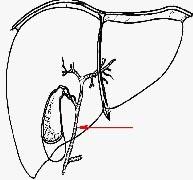 In the drawing to the right, the red arrow is pointing to which of
the following structures? | back 170 A. Common bile duct -The hepatic duct (leaving the liver) and the cystic duct (leaving the gallbladder) join together to form the common bile duct which empties bile into the duodenum. |
front 171 A digital image receptor exposed to 50% less radiation than optimal
will display which of the following? | back 171 B. Quantum noise -An insufficient number of x rays will cause a grainy image. This grainy appearance is called quantum noise. |
front 172 Which of the following speed classes will produce the longest time to
process an image? | back 172 D. 400 |
front 173 How many milliseconds are in .10 seconds? | back 173 C. 100 -The prefix "milli" stands for 1/1000 (one thousandth). There are 1000 milliseconds in 1 second or 100 milliseconds in .1 seconds |
front 174 What is the greatest advantage of digital imaging? | back 174 A. Contrast resolution -Digital imaging's exceptional ability to differentiate between the slight differences in subject contrast is its greatest advantage |
front 175 How much should the patient be obliqued for a scapular Y position of
the shoulder? | back 175 C. 45 degrees -The scapular Y position is used to rule out dislocation or fractures of the proximal humerus. |
front 176 When does foreshortening occur? | back 176 A. When the object is angled and the CR and image receptor are perpendicular -Foreshortening only occurs when the object is angled. |
front 177 Which of the following defines the ability of an image receptor to
record a wide range of exposures? | back 177 C. Latitude -Latitude is the image receptor's ability to record a range of exposures that fall within the diagnostic range |
front 178 Which of the following are reasons for nasogastric tubes? | back 178 A. 1 & 2 only -Central venous catheters like the Hickman and PIC are used for measuring central venous pressure |
front 179 Which of the following exposure indicator numbers indicates that the
patient was overexposed? | back 179 A. 2.5 -Agfa's perfect log median number is 2.2. Anything above that would indicate an overexposure. 2.5 indicates the patient received twice the necessary exposure. |
front 180 Which of the digital radiography systems use exposure indicators
(e.g., S-number) to express the radiation dose received by the image
receptor? | back 180 C. Computed radiography -Fuji calls it the S-number, Carestream calls it an exposure index (EI), and Agfa refers to it as log-median |
front 181 Why is a small focal spot valuable to radiographic quality? | back 181 A. Improves spatial resolution -The smaller the focal spot size, the less unsharpness and the better the spatial resolution. |
front 182 Radiation that passes through the tube housing in directions other
than that of the useful beam is termed what? | back 182 C. Leakage -Ideally, any radiation other than the primary beam, will get absorbed by the lead impregnated glass tube or tube housing |
front 183 Epinephrine (Adrenalin) would be the drug needed for which of the
following symptoms? | back 183 C. Bronchospasms -Epinephrine (Adrenalin) is classified as a bronchodilator. It increases the size of the bronchioles |
front 184 Data corruption can occur during: | back 184 D. all of the above |
front 185 Which of the following statements concerning mobile imaging is/are
true? | back 185 D. 1, 2 & 3 |
front 186 Where does the CR enter for a PA finger only projection of the 3rd
digit? | back 186 B. 3rd proximal interphalangeal joint -The CR is perpendicular, and enters at the 3rd proximal interphalangeal joint |
front 187 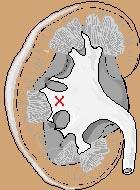 The red X is lying directly over which anatomical part of the
kidney? | back 187 C. Major calyx -The major calyces drain into the renal pelvis |
front 188 Which of the following positions will best demonstrate the right
colic flexure of the colon? | back 188 C. RAO -The RAO (right anterior oblique) position best demonstrates the right colic flexure and the LAO (left anterior oblique) best demonstrates the left colic flexure. |
front 189 What is the average pulse rate for an adult? | back 189 C. 70-80 beats per minute -An adult's pulse rate under normal conditions would be 70 beats per minute; higher when active or under stress |
front 190 The hematopoietic system includes which of the following? | back 190 A. Bone marrow -The hematopoietic system includes bone marrow, circulating blood, lymph nodes, and spleen. |
front 191 Pneumonia is described by which of the following? | back 191 A. An acute inflammation of the lung -An acute inflammation (-itis) of the lungs describes pneumonia, which is caused primarily by bacteria, viruses, and chemical irritants |
front 192 In opening a wrapped sterile package, how should the first outer
corner of the wrap be opened? | back 192 C. Away from you -The first wrap should be opened away from you so you won't have to reach over the sterile area to open the other three corners. |
front 193 Digital imaging systems with high detective quantum efficiency (DQE)
can produce _______ quality images at ______ patient doses. | back 193 C. higher, lower -The better the system can detect the radiation, the better the image at a lower dose to the patient |
front 194 Which of the following positions will best demonstrate the scaphoid
bone in the wrist? | back 194 A. PA - ulnar deviation -The scaphoid is near the radius. PA - ulnar deviation (moving the hand toward the ulna) opens the joints between the adjacent carpal bones |
front 195 A zygapophyseal joint is an articulation between which two vertebral
structures? | back 195 C. Inferior and superior articular processes -The cervical zygapophyseal joints are best demonstrated in
a lateral position, the thoracic zygapophyseal joints are best
demonstrated in a |
front 196 During which time period is the fetus most susceptible to the effects
of radiation? | back 196 A. First trimester -According to the Law of Bergone and Tribondeau, the younger the tissues and organs are the more radiosensitive they are. Therefore, elective radiologic examinations should not be conducted during the first trimester |
front 197 Which of the following anatomical structures is (are) demonstrated in
a 45 degree oblique view of the cervical spine? | back 197 C. 1 & 3 only -The zygapophyseal joints will be best demonstrated in the lateral position of the cervical spine |
front 198 How many phalanges are there in each foot? | back 198 C. 14 -Phalanges are the small bones that make up the digits
(toes) of the foot. There are two phalanges in the 1st digit and
three phalanges in the |
front 199 Which of the following is correct for an AP projection of the upper
airway? | back 199 A. The acanthiomeatal line is perpendicular to the image receptor -The chin must be raised to get an unobstructed view of the upper airway. |
front 200 The allowable radiation dosage that is assumed to result in an
average nominal lifetime risk is known as what? | back 200 B. Equivalent dose limits -Even though any radiation exposure is considered potentially harmful, anyone receiving less than the equivalent dose limits is considered to be in a safe environment. |